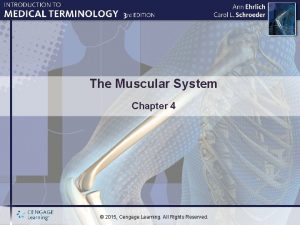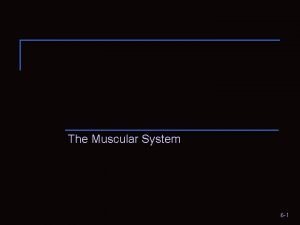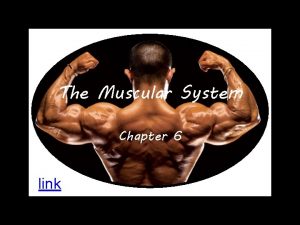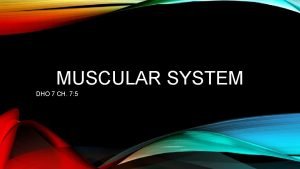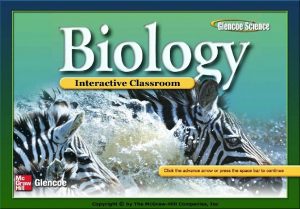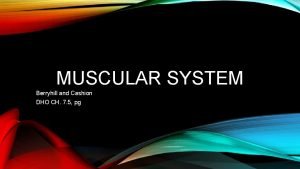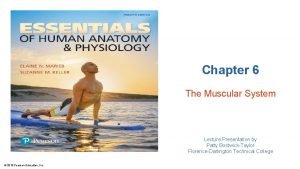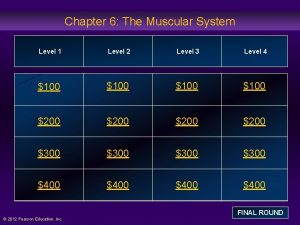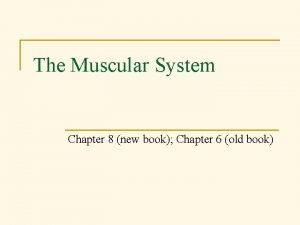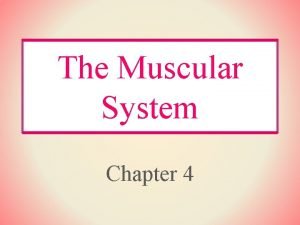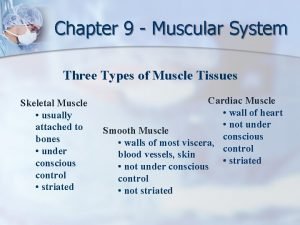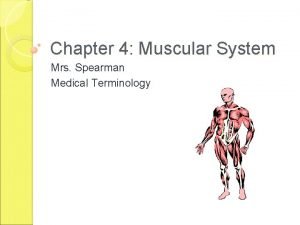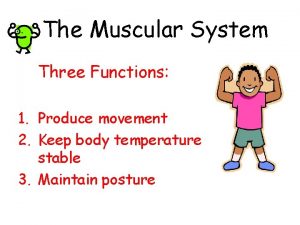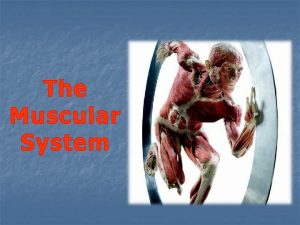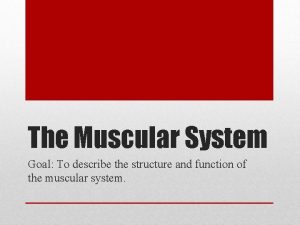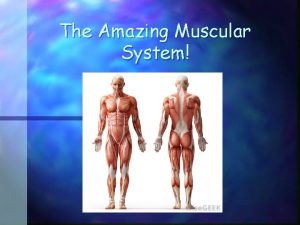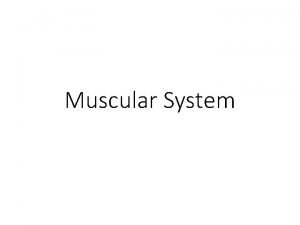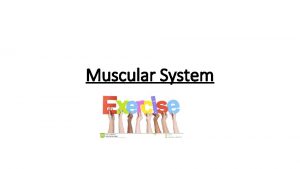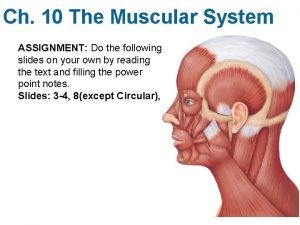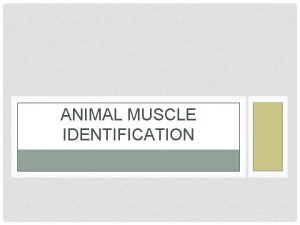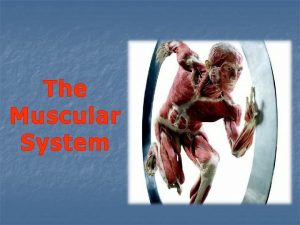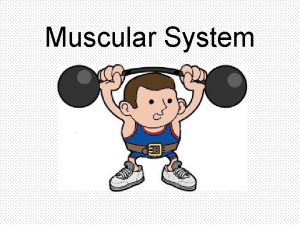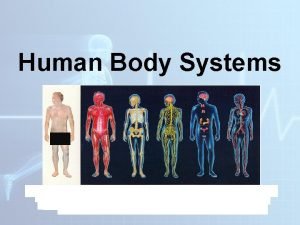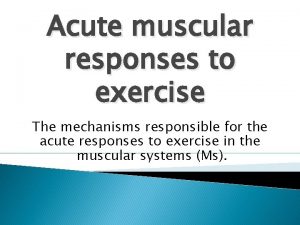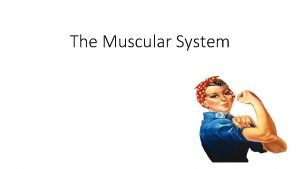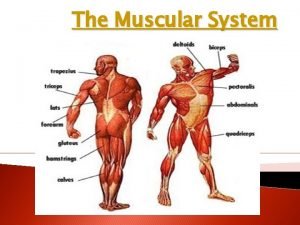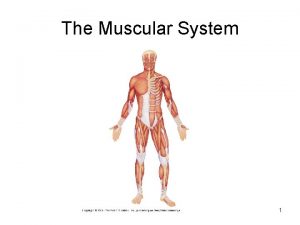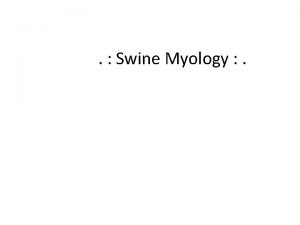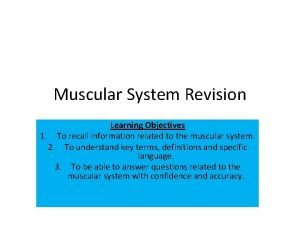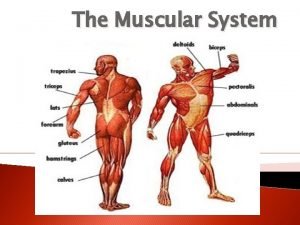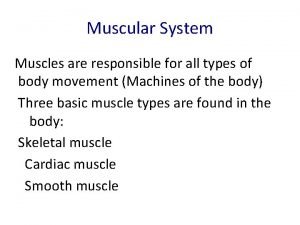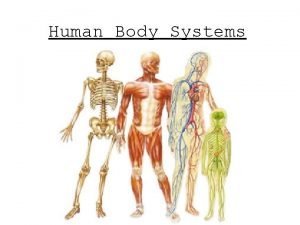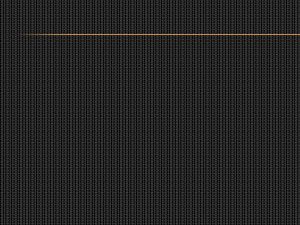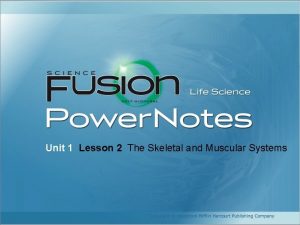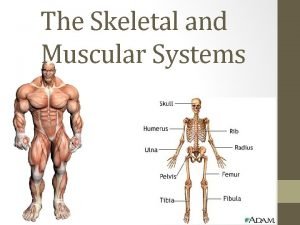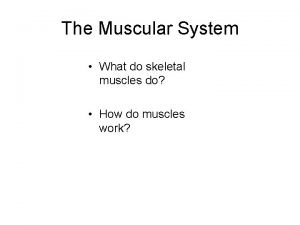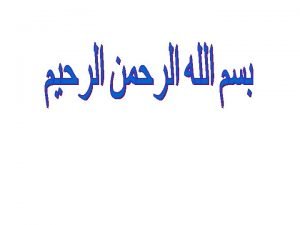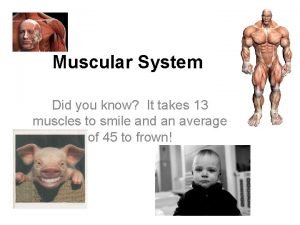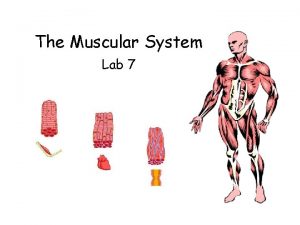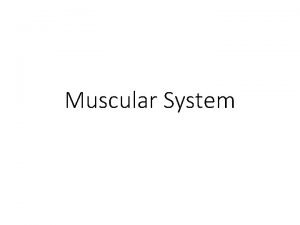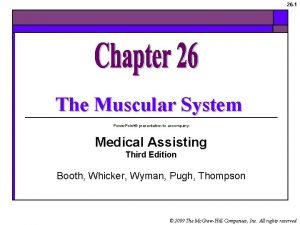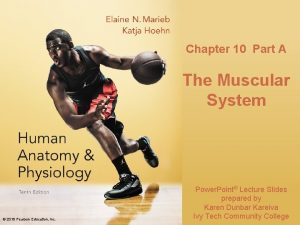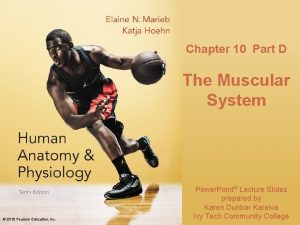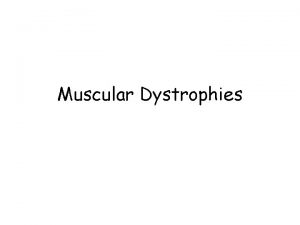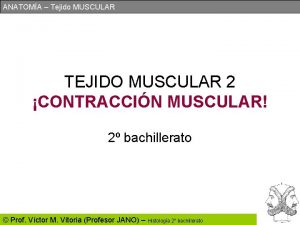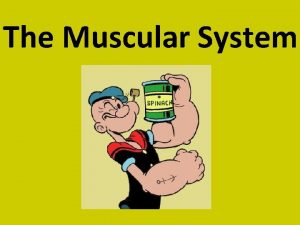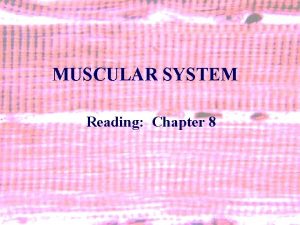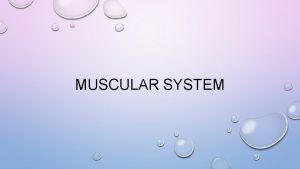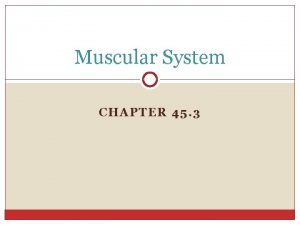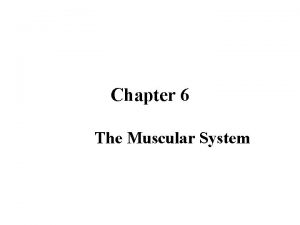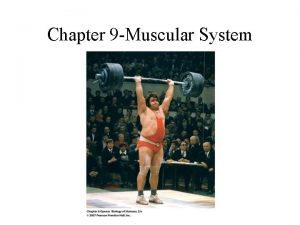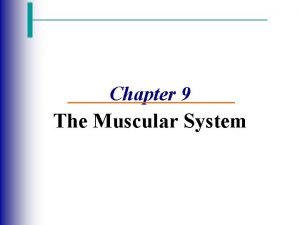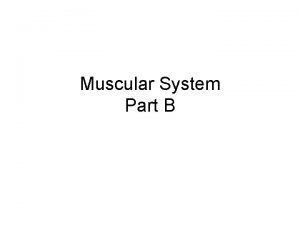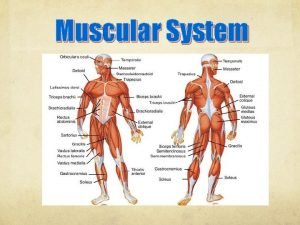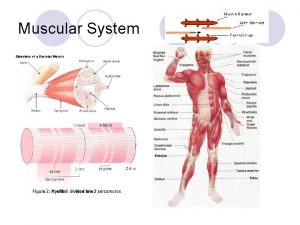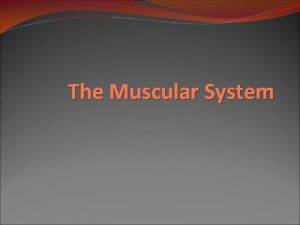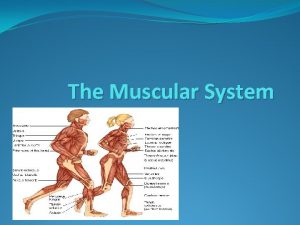Chapter 10 Part A The Muscular System Annie























































- Slides: 55

Chapter 10 Part A The Muscular System © Annie Leibovitz/Contact Press Images © 2016 Pearson Education, Inc. Power. Point® Lecture Slides prepared by Karen Dunbar Kareiva Ivy Tech Community College

10. 1 Muscle Actions and Interactions • This chapter focuses on skeletal muscle and looks at: – How muscles interact to bring about movement – Criteria for naming muscles – Principles of leverage © 2016 Pearson Education, Inc.

Muscle Actions and Interactions (cont. ) • Muscles can only pull; never push © 2016 Pearson Education, Inc.

Muscle Actions and Interactions (cont. ) • Functional groups – Prime mover (agonist) • Major responsibility for producing specific movement – Antagonist • Opposes or reverses particular movement – Prime mover and antagonist are located on opposite sides of joint across which they act © 2016 Pearson Education, Inc.

Muscle Actions and Interactions (cont. ) • Synergist helps prime movers – Adds extra force to same movement – Reduces undesirable or unnecessary movement • Fixator – Type of synergist that immobilizes the origin – Gives prime mover stable base on which to act © 2016 Pearson Education, Inc.

Focus Figure 10. 1 a The action of a muscle can be inferred by the position of the muscle relative to the joint it crosses. (Examples given relate to the shoulder joint. ) A muscle that crosses on the anterior side of a joint produces flexion* Example: Pectoralis major (anterior view) * These generalities do not apply to the knee and ankle because the lower limb is rotated during development. The muscles that cross these joints posteriorly produce flexion, and those that cross anteriorly produce extension. © 2016 Pearson Education, Inc.

Focus Figure 10. 1 b The action of a muscle can be inferred by the position of the muscle relative to the joint it crosses. (Examples given relate to the shoulder joint. ) A muscle that crosses on the posterior side of a joint produces extension* Example: Latissimus dorsi (posterior view) The latissimus dorsi is an antagonist of the pectoralis major. * These generalities do not apply to the knee and ankle because the lower limb is rotated during development. The muscles that cross these joints posteriorly produce flexion, and those that cross anteriorly produce extension. © 2016 Pearson Education, Inc.

Focus Figure 10. 1 c The action of a muscle can be inferred by the position of the muscle relative to the joint it crosses. (Examples given relate to the shoulder joint. ) A muscle that crosses on the lateral side of a joint produces abduction Example: Deltoid middle fibers (anterolateral view) © 2016 Pearson Education, Inc.

Focus Figure 10. 1 d The action of a muscle can be inferred by the position of the muscle relative to the joint it crosses. (Examples given relate to the shoulder joint. ) A muscle that crosses on the medial side of a joint produces adduction Example: Teres major (posterolateral view) The teres major is an antagonist of the deltoid. © 2016 Pearson Education, Inc.

Skeletal Muscles: Functional Groups • Same muscle may be: – Prime mover of one movement – Antagonist for different movement – Synergist for third movement © 2016 Pearson Education, Inc.

10. 2 Naming Skeletal Muscles Seven ways to describe and name muscles: © 2016 Pearson Education, Inc.

10. 2 Naming Skeletal Muscles 1. Muscle location: bone or body region with which muscle associated – Example: temporalis (over temporal bone) 2. Muscle shape: distinctive shapes – Example: deltoid muscle (deltoid = triangle) 3. Muscle size – Example: maximus (largest), minimus (smallest) © 2016 Pearson Education, Inc.

10. 2 Naming Skeletal Muscles 4. Direction of muscle fibers or fascicles – Example: rectus (fibers run straight), transversus (fibers run at right angles) oblique (fibers run at angles to imaginary axis) 5. Number of origins – Example: biceps (two origins) and triceps (three origins) © 2016 Pearson Education, Inc.

10. 2 Naming Skeletal Muscles 6. Location of attachments: named according to point of origin and insertion (origin named first) – Example: sternocleidomastoid attaches to sternum and clavicle, with insertion on mastoid process 7. Muscle action: named for action they produce – Example: flexor or extensor © 2016 Pearson Education, Inc.

10. 2 Naming Skeletal Muscles • Several criteria can be combined – Example: extensor (extends) carpi (wrist) radialis (radius) longus (length is long) © 2016 Pearson Education, Inc.

10. 4 Lever Systems • Most skeletal muscles move using leverage © 2016 Pearson Education, Inc.

10. 4 Lever Systems • Components of lever system 1. Lever: rigid bone that moves on a fixed point called fulcrum (joint) 2. Effort: force applied to lever to move resistance (load) 3. Load: resistance (bone + tissues + any added weight) moved by the effort © 2016 Pearson Education, Inc.

Levers: Power Versus Speed • Levers allow given effort to move heavier load or to move load farther or faster © 2016 Pearson Education, Inc.

10. 5 Major Skeletal Muscles of the Body • > 600 muscles; grouped by function and location © 2016 Pearson Education, Inc.

10. 5 Major Skeletal Muscles of the Body • Muscle tables include following information: – – Description: includes location relative to other muscles Origin and insertion Actions: movement that contraction causes Innervation: major nerve that supplies muscle © 2016 Pearson Education, Inc.

10. 5 Major Skeletal Muscles of the Body • Tips for learning muscles: 1. 2. 3. 4. Use the information learned from the muscle’s name Read description in table, and identify muscle on figure Relate muscle’s location and attachments to its actions Act out movements on yourself • Feel for muscles contracting beneath skin © 2016 Pearson Education, Inc.

Figure 10. 4 Superficial muscles of the body: Anterior view. Head Temporalis Masseter Shoulder Trapezius Deltoid Arm Triceps brachii Brachialis Forearm Pronator teres Brachioradialis Flexor carpi radialis Palmaris longus Facial Epicranius, frontal belly Orbicularis oculi Zygomaticus Orbicularis oris Neck Platysma Sternohyoid Sternocleidomastoid Thorax Pectoralis minor Pectoralis major Serratus anterior Intercostals Abdomen Rectus abdominis External oblique Internal oblique Transversus abdominis Pelvis/thigh Iliopsoas Pectineus Thigh Rectus femoris Vastus lateralis Vastus medialis Leg Fibularis longus Extensor digitorum longus Tibialis anterior Thigh Tensor fascia lata Sartorius Adductor longus Gracilis Leg Gastrocnemius Soleus © 2016 Pearson Education, Inc.

Figure 10. 5 Superficial muscles of the body: Posterior view. Splenius capitis Splenius cervicis Levator scapulae Rhomboid minor Rhomboid major Arm Triceps brachii Brachialis Forearm Brachioradialis Extensor carpi radialis longus Flexor carpi ulnaris Extensor digitorum Neck Epicranius, occipital belly Sternocleidomastoid Trapezius Shoulder Deltoid Infraspinatus Teres major Rhomboid major Latissimus dorsi Hip Gluteus medius Gluteus maximus Iliotibial tract Leg Gastrocnemius Soleus Fibularis longus Calcaneal (Achilles) tendon © 2016 Pearson Education, Inc. Thigh Adductor magnus Gracilis Hamstrings: Biceps femoris Semitendinosus Semimembranosus

Table 10. 1: Muscles of the Head, Part 1: Facial Expression • Facial expression muscles are different because they insert into skin, not bone • Important in nonverbal communication • All innervated by cranial nerve VII (facial nerve) © 2016 Pearson Education, Inc.

Table 10. 1 -1 Muscles of the Head, Part I: Facial Expression © 2016 Pearson Education, Inc.

Table 10. 1 -2 Muscles of the Head, Part I: Facial Expression (continued) © 2016 Pearson Education, Inc.

Table 10. 1 -3 Muscles of the Head, Part I: Facial Expression (continued) © 2016 Pearson Education, Inc.

Table 10. 1 -4 Muscles of the Head, Part I: Facial Expression (continued) © 2016 Pearson Education, Inc.

Figure 10. 6 b Lateral view of muscles of the scalp, face, and neck. Epicranial aponeurosis Corrugator supercilii Orbicularis oculi Levator labii superioris Zygomaticus minor and major Buccinator Risorius Orbicularis oris Mentalis Depressor labii inferioris Depressor anguli oris Platysma © 2016 Pearson Education, Inc. Frontal belly Epicranius Occipital belly Temporalis Masseter Sternocleidomastoid Trapezius Splenius capitis

Figure 10. 7 Muscles used in facial expressions. Zygomaticus major (smile) Orbicularis oris (pucker) Mentalis (pout) Platysma (tense neck) Corrugator supercilii (angry eyebrows) © 2016 Pearson Education, Inc. Orbicularis oculi (blink) Frontal belly of epicranius (raised eyebrows/wrinkled forehead)

Table 10. 2: Muscles of the Head, Part 2: Mastication and Tongue Movement • Muscles of mastication – Four pairs all innervated by cranial nerve V • Prime movers of jaw closure: temporalis and masseter • Grinding movements: pterygoids • Chewing role: buccinator © 2016 Pearson Education, Inc.

Table 10. 2 -1 Muscles of the Head, Part II: Mastication and Tongue Movement © 2016 Pearson Education, Inc.

Figure 10. 8 a Muscles promoting mastication and tongue movements. Temporalis Orbicularis oris Buccinator © 2016 Pearson Education, Inc. Masseter

Figure 10. 8 b Muscles promoting mastication and tongue movements. Lateral pterygoid Medial pterygoid Masseter pulled away © 2016 Pearson Education, Inc.

Table 10. 2 -2 Muscles of the Head, Part II: Mastication and Tongue Movement (continued) © 2016 Pearson Education, Inc.

Figure 10. 8 c Muscles promoting mastication and tongue movements. Tongue Genioglossus Mandibular symphysis Geniohyoid Thyroid cartilage © 2016 Pearson Education, Inc. Styloid process Styloglossus Hyoglossus Stylohyoid Hyoid bone Thyrohyoid

Table 10. 3: Muscles of the Anterior Neck and Throat: Swallowing • Sternocleidomastoid muscle divides neck into two triangles (anterior and posterior) – Anterior muscles are divided based on location to the hyoid bone: suprahyoid and infrahyoid • Tongue and buccinator muscles push food back towards pharynx, where muscles in posterior mouth and pharynx complete swallowing process • Epiglottis closes over larynx while muscles in walls of pharynx propel food forward to stomach © 2016 Pearson Education, Inc.

Table 10. 3: Muscles of the Anterior Neck and Throat: Swallowing (cont. ) • Suprahyoid muscles – Four deep muscles involved in swallowing (move hyoid bone and larynx) • • Form floor of oral cavity Anchor tongue Elevate hyoid bone Move larynx during swallowing © 2016 Pearson Education, Inc.

Table 10. 3 -1 Muscles of the Anterior Neck and Throat: Swallowing © 2016 Pearson Education, Inc.

Table 10. 3: Muscles of the Anterior Neck and Throat: Swallowing (cont. ) • Infrahyoid muscles – Four straplike muscles – Depress hyoid bone and larynx during swallowing and speaking © 2016 Pearson Education, Inc.

Table 10. 3 -2 Muscles of the Anterior Neck and Throat: Swallowing (continued) © 2016 Pearson Education, Inc.

Figure 10. 9 a Muscles of the anterior neck and throat used in swallowing. Median raphe Anterior belly Digastric Posterior belly Stylohyoid (cut) Thyrohyoid Thyroid cartilage of the larynx Thyroid gland Sternothyroid © 2016 Pearson Education, Inc. Mylohyoid Stylohyoid Hyoid bone Omohyoid (superior belly) Sternohyoid Sternocleidomastoid Omohyoid (inferior belly)

Figure 10. 9 b Muscles of the anterior neck and throat used in swallowing. Platysma (cut) Mylohyoid Omohyoid (superior belly) Sternohyoid Sternocleidomastoid © 2016 Pearson Education, Inc.

Figure 10. 9 c Muscles of the anterior neck and throat used in swallowing. Tensor veli palatini Levator veli palatini Styloid process Superior pharyngeal constrictor Buccinator Middle pharyngeal constrictor Mandible Hyoid bone Thyrohyoid membrane Inferior pharyngeal constrictor Esophagus © 2016 Pearson Education, Inc. Mylohyoid (cut) Geniohyoid Hyoglossus Thyroid cartilage of larynx Trachea

Table 10. 4: Muscles of the Neck and Vertebral Column: Head Movements and Trunk Extension • Two functional groups – Anterolateral neck muscles: move head – Intrinsic muscles of the back: extend trunk and maintain posture © 2016 Pearson Education, Inc.

Table 10. 4 -1 Muscles of the Neck and Vertebral Column: Head Movements and Trunk Extension © 2016 Pearson Education, Inc.

Figure 10. 10 a Muscles of the neck and vertebral column that move the head and trunk. 1 st cervical vertebra Sternocleidomastoid Base of occipital bone Mastoid process Middle scalene Anterior scalene Posterior scalene Anterior © 2016 Pearson Education, Inc.

Table 10. 4 -1 Muscles of the Neck and Vertebral Column: Head Movements and Trunk Extension © 2016 Pearson Education, Inc.

Table 10. 4 -2 Muscles of the Neck and Vertebral Column: Head Movements and Trunk Extension (continued) © 2016 Pearson Education, Inc.

Table 10. 4 -3 Muscles of the Neck and Vertebral Column: Head Movements and Trunk Extension (continued) © 2016 Pearson Education, Inc.

Table 10. 4 -3 Muscles of the Neck and Vertebral Column: Head Movements and Trunk Extension (continued) © 2016 Pearson Education, Inc.

Figure 10. 10 b Muscles of the neck and vertebral column that move the head and trunk. Mastoid process Splenius capitis Spinous processes of the vertebrae Splenius cervicis Posterior © 2016 Pearson Education, Inc.

Figure 10. 10 c Muscles of the neck and vertebral column that move the head and trunk. Platysma (cut) Sternocleidomastoid (cut) Internal jugular vein Omohyoid Sternothyroid Sternocleidomastoid Pectoralis major © 2016 Pearson Education, Inc.

Figure 10. 10 d Muscles of the neck and vertebral column that move the head and trunk. Mastoid process of temporal bone Longissimus capitis Iliocostalis cervicis Longissimus cervicis Iliocostalis thoracis Longissimus thoracis Spinalis thoracis Ligamentum nuchae Semispinalis capitis Semispinalis cervicis Semispinalis thoracis Iliocostalis Erector Longissimus spinae Spinalis Multifidus Iliocostalis lumborum External oblique © 2016 Pearson Education, Inc. Quadratus lumborum

Figure 10. 10 e Muscles of the neck and vertebral column that move the head and trunk. I I Intertransversarius O O = origin I = insertion Rotatores I Multifidus O Interspinales I O © 2016 Pearson Education, Inc. I O
 Difference between strength and endurance
Difference between strength and endurance Dorsiflexion word parts
Dorsiflexion word parts Muscular system figure
Muscular system figure The muscular system chapter 6
The muscular system chapter 6 Chapter 6 the muscular system figure 6-12
Chapter 6 the muscular system figure 6-12 7:5 muscular system
7:5 muscular system Chapter 9 muscular system
Chapter 9 muscular system Chapter 32 section 3 the muscular system answer key
Chapter 32 section 3 the muscular system answer key Dorsifelxion
Dorsifelxion Chapter 7:5 muscular system
Chapter 7:5 muscular system Chapter 6 the muscular system
Chapter 6 the muscular system Cengage chapter 4
Cengage chapter 4 Chapter 6 the muscular system
Chapter 6 the muscular system Chapter 6 the muscular system
Chapter 6 the muscular system Muscles that have their fasciculi arranged like barbs
Muscles that have their fasciculi arranged like barbs Chapter 8 the muscular system
Chapter 8 the muscular system The muscular system chapter 4
The muscular system chapter 4 Structures of the muscular system
Structures of the muscular system Define myocele
Define myocele Three functions of muscular system
Three functions of muscular system Muscular system primary function
Muscular system primary function 4 function of muscular system
4 function of muscular system Amazing facts about the muscular system
Amazing facts about the muscular system Myofirbril
Myofirbril Muscular system label
Muscular system label Muscular system head and neck
Muscular system head and neck Brachiocephalicus
Brachiocephalicus Navigating the body movements of the body #1
Navigating the body movements of the body #1 Muscular system primary function
Muscular system primary function Whats the purpose of the muscular system
Whats the purpose of the muscular system Sarcomore
Sarcomore Muscular system response to exercise
Muscular system response to exercise How your muscular system works
How your muscular system works Muscles of the body
Muscles of the body Muscle levels
Muscle levels Superficial muscular system
Superficial muscular system Porcine myology
Porcine myology Muscular system learning objectives
Muscular system learning objectives What are the major functions of the muscular system
What are the major functions of the muscular system I band h zone
I band h zone 3 function of muscular system
3 function of muscular system Esternocleidomastoideo
Esternocleidomastoideo Lesson 2 muscle storyboard
Lesson 2 muscle storyboard The muscular system
The muscular system Skeletal and muscular system
Skeletal and muscular system Named
Named Muscular system worksheet answers
Muscular system worksheet answers Muscle diagram
Muscle diagram Muscular system diagram
Muscular system diagram Whats the job of the muscular system
Whats the job of the muscular system Tissue
Tissue Sarcolemma
Sarcolemma Skeletal and muscular system
Skeletal and muscular system Muscular system
Muscular system Chapter 36 skeletal muscular and integumentary systems
Chapter 36 skeletal muscular and integumentary systems Chapter 14 the skeletal muscular and nervous systems
Chapter 14 the skeletal muscular and nervous systems

